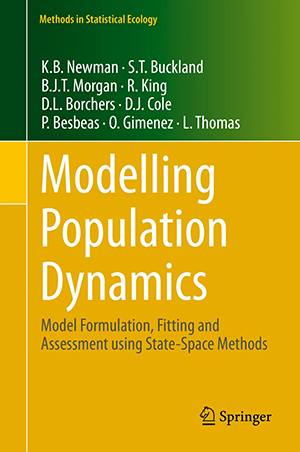Modelling Population Dynamics: Chapter 7
Survival estimation from mark-re-encounter data
Section 7.2.1 Capture-recapture data
WinBugs implementation of Cormack-Jolly-Seber model
model
{
for (i in 1:n) # loop over individuals
{
# State-space model likelihood
px[i,f[i]] <- 1
z[i, f[i]] ~ dbern(px[i,f[i]]) # initial state is alive (= 1)
for (j in (f[i]+1):K) # loop over time (after first capture)
{
# state probabilities 'px' (= 0 if dead at t-1, = phi if alive at t-1)
px[i,j] <- phi[j-1] * z[i,j-1]
# state equation (sample state at t given state at t-1)
z[i,j] ~ dbern(px[i,j])
# observation probabilities 'po' (= 0 if dead at t, = p if alive at t)
po[i,j] <- p[j-1] * z[i, j]
# observation equation (sample observation at t given state at t)
y[i, j] ~ dbern(po[i,j])
}
}
# Priors
for (j in 1:(T-1))
{
phi[j] ~ dunif(0, 1) # survival probability
p[j] ~ dunif(0,1) # resighting probability
}
}
Section 7.2.4 Capture-recapture of European Dipper data
Data themselves reside in file named ed.dat
WinBUGS model (named “phitpt.bug” in subsequent R code)
# State-space modelling of mark-recapture data
model
{
for (i in 1:n) # loop / individual
{
px[i,f[i]] <- 1
z[i, f[i]] ~ dbern(px[i,f[i]]) # initial state is alive (= 1)
for (j in (f[i]+1):K) # loop / individual (after first capture)
{
# state probabilities 'px' (= 0 if dead at t-1, = phi if alive at t-1)
px[i,j] <- phi[j-1] * z[i,j-1]
# state equation (sample state at t given state at t-1)
z[i,j] ~ dbern(px[i,j])
# observation probabilities 'po' (= 0 if dead at t, = p if alive at t)
po[i,j] <- p[j-1] * z[i, j]
# observation equation (sample observation at t given state at t)
y[i, j] ~ dbern(po[i,j])
}
}
# Priors
for (j in 1:(K-1))
{
phi[j] ~ dunif(0, 1) # survival probability
p[j] ~ dunif(0,1) # resighting probability
}
}Finally the R code to calling R2WinBUGS
niter = 500
nburn = 50
#------------------------------#
#--- model (phi-t,p-t) --------#
#------------------------------#
# read encounter histories
setwd("appropriate for your local configuration")
data <- as.matrix(read.table("ed.dat")) # file of encounter histories
# number of individuals
n <- dim(data)[[1]]
# number of capture events
K <- dim(data)[[2]]
# compute the date of first capture
fc <- NULL
for (i in 1:n)
{
temp <- 1:K
fc <- c(fc,min(temp[data[i,]==1]))
}
# data
datax <- list(n=n,K=K,y=data,f=fc)
# list of inits for states
dataIV = data
for (i in 1:n)
{
if (fc[i] > 1)
{
for (j in 1:(fc[i]-1))
{dataIV[i,j] = NA}
}
}
# first list of inits
init1 <- list(p=rep(0.1,6),phi=rep(0.1,6),z=as.matrix(dataIV))
# second list of inits
init2 <- list(p=rep(0.9,6),phi=rep(0.9,6),z=as.matrix(dataIV))
# concatenate initial values
inits <- list(init1,init2)
# parameters to be monitored
parameters <- c("phi","p")
# do the MCMC stuff calling WinBUGS
library(R2WinBUGS)
deb = Sys.time()
sim.phitpt <- bugs(datax, inits, parameters,"phitpt.bug", n.chains=2, n.iter=niter,n.burnin = nburn)
fin = Sys.time()
duree = fin-deb
save(sim.phitpt,duree,file = "CJSmodel.Rdata")
round(sim.phitpt$summary,2)

